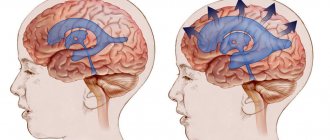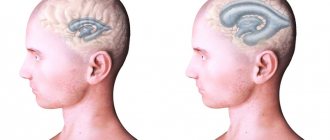Minor external hydrocephalus of the brain can be an independent pathology or a manifestation of various diseases. To diagnose moderate external hydrocephalus, doctors at the Yusupov Hospital conduct a comprehensive examination of patients using modern equipment from leading European and American manufacturers. Using innovative research methods, neurologists find out the cause and form of the disease. To treat patients suffering from minor external hydrocephalus, the most effective drugs are used that do not have significant side effects.
Professors and doctors of the highest category take an individual approach to the treatment of each patient. Patients with minor external hydrocephalus of the brain are treated with conservative therapy. As the symptoms of the disease progress, neurosurgeons at partner clinics perform surgical interventions that restore the physiological flow of cerebrospinal fluid. At a meeting of the expert council, doctors discuss all severe cases of hydrocephalus and make a collective decision regarding further treatment of the patient.
Causes of hydrocephalus
With this disease, the balance between the formation, circulation and absorption of cerebrospinal fluid is disrupted. The causes of hydrocephalus have not been fully elucidated.
Hydrocephalus in a child is usually the result of inherited genetic abnormalities and congenital disorders of the brain and spinal cord. It can also occur after premature birth, during which hemorrhage occurred in the ventricles of the newborn’s brain.
Hydrocephalus of the brain in an adult can have the following causes:
- meningitis;
- brain tumors;
- traumatic brain injury;
- subarachnoid hemorrhage;
- other conditions that impede the release of cerebrospinal fluid from the ventricles into the cisterns of the brain.
Hydrocephalus
Hydrocephalus is a disease characterized by the expansion of cerebrospinal fluid cavities as a result of impaired cerebrospinal fluid dynamics and excessive accumulation of cerebrospinal fluid. Currently, hydrocephalus remains one of the most difficult problems in pediatric neurosurgery. The progressive course of this disease leads to severe neurological and mental disorders with retardation in physical development. Currently, there are many classifications of hydrocephalus, which are based on etiopathogenetic, morphological features, the nature of clinical manifestations, course and prognosis of the disease. Hydrocephalus that develops in the prenatal period is called congenital, after birth - acquired (due to inflammatory diseases of the brain and its membranes, traumatic injuries, including birth trauma, congenital malformations of the central nervous system, brain tumors). The most common is the division of hydrocephalus into a communicating form (in which cerebrospinal fluid accumulates mainly in the intrathecal spaces of the brain) and occlusive (accompanied by the accumulation of cerebrospinal fluid in the ventricles of the brain). Depending on the location of the block of the cerebrospinal fluid pathways, occlusive hydrocephalus is divided into monoventricular (dilation of one ventricle of the brain), biventricular (with dilation of the lateral ventricles), triventricular (accompanied by dilatation of the lateral and third ventricles of the brain) and tetraventricular (dilation of the entire ventricular system). Along the course, progressive, stationary and regressive forms are distinguished depending on the dynamics of the manifestations of the disease over time. Hydrocephalus is also divided into compensated and decompensated forms. Decompensated forms include hydrocephalus with high intracranial pressure (hypertensive), occlusive and progressive hydrocephalus. Compensated forms of the disease include a pathological process with a regressive type of course, without persistent disorders of liquorodynamics and signs of increasing clinical manifestations of the disease. The leading symptom of congenital hydrocephalus is a rapid, faster than normal increase in the size of the child’s head after birth. Enlargement of the head is accompanied by an increase in the fontanels, their swelling and tension, divergence of cranial sutures, thinning of the skull bones, a characteristic change in its configuration with a significant predominance of the brain over the facial, pronounced frontal and parietal tubercles, a sharp increase in the pattern and plethora of the saphenous veins of the head, a symptom of the “setting sun” "(the area of sclera between the iris and the upper eyelid is visible). Infants often experience a forced body position with their head thrown back. As hydrocephalus progresses, the child experiences delayed psychomotor development. In older children, after closure of the fontanelles, hydrocephalus manifests itself as hypertensive-hydrocephalic syndrome in the form of intense headaches, vomiting, general weakness, fatigue, drowsiness, and irritability. In rare cases, the development of epileptic seizures. Currently, the diagnosis of hydrocephalus is based on the clinical picture, examination of the fundus, as well as additional research methods that make it possible to clarify the form of hydrocephalus and the nature of its course.
One of the important methods of examining pediatric patients was neurosonography (ultrasound examination of the brain). The presence of open fontanelles makes it quite easy to assess the form of hydrocephalus, the degree and dynamics of deformation of the liquor-containing cavities, to identify intracranial space-occupying formations (tumors, hematomas, cysts), and some malformations of the brain.
According to computed tomography (CT) and magnetic resonance imaging (MRI) of the brain, the nature, shape and severity of hydrocephalus, the level of blockage of the liquor pathways, the degree of periventricular changes, and the condition of the subarachnoid spaces are assessed.
Children with hydrocephalus are advised to consult an ophthalmologist with ophthalmoscopy to timely identify the initial signs of optic disc atrophy. In rare cases, ventricular or lumbar puncture is used to assess the pressure of cerebrospinal fluid, study its composition and perform liquorodynamic tests. For occlusive hydrocephalus, surgical treatment methods are always used, aimed at eliminating obstacles to the flow of cerebrospinal fluid, removing excess volume of cerebrospinal fluid, eliminating deformation of the cerebrospinal fluid-containing systems of the brain, and normalizing intracranial pressure. The following types of surgical operations are performed in our department: liquor shunting – ventriculoperitoneostomy, ventriculoatriostomy; endoscopic – aqueductoplasty, triventriculostomy, as well as combined endoscopic and cerebrospinal fluid shunting interventions.
The most common operation is ventriculoperitoneal shunt (VPS). The purpose of the operation is to divert cerebrospinal fluid from the ventricles of the brain into the abdominal cavity, where it is absorbed between the intestinal loops. This uses a system of silicone catheters and a valve that regulates the amount of leaking cerebrospinal fluid, which are implanted subcutaneously and are not visible from the outside. In some cases, cerebrospinal fluid is diverted into the right atrium (ventriculoatrial shunt).
With the development of modern endoscopic technology, it has become possible to treat patients without installing liquor shunt systems. The operation is called endoscopic triventriculostomy. The purpose of the operation is to create a bypass path by forming an anastomosis between the cavity of the third ventricle and the cisterns of the base of the brain, where cerebrospinal fluid can be absorbed. However, it should be borne in mind that endoscopic triventriculostomy is effective only in a limited number of patients (about 15%) and has clear indications for its implementation.
A successful operation stops the progression of the disease. Most children have the opportunity to return to normal life, attend kindergarten and school.
Classification of the disease
There are three main forms of pathology:
- occlusive hydrocephalus, or internal, is a condition in which fluid does not flow from the ventricles, while the space around the brain is compressed;
- non-occlusive hydrocephalus, or external - fluid can enter from the ventricles into the space between the brain and its membranes, while they expand and compress the nervous tissue from the outside;
- mixed hydrocephalus is a combination of several blocks of cerebrospinal fluid outflow pathways.
External replacement hydrocephalus is a severe form in which the substance of the cerebral cortex atrophies, and excess fluid takes its place. A synonym for this condition is atrophic hydrocephalus.
The disease is also divided depending on its causes into post-traumatic, post-infectious and post-hemorrhagic forms. Hydrocephalus can be progressive (active) or chronic (compensated). It is accompanied by an increase in intracranial pressure.
Hydrocephalus: symptoms
If you notice the following symptoms in your little child:
– rapid increase in head circumference, – enlarged and swollen fontanel, – pronounced venous pattern on the forehead and face, – oculomotor disorders (strabismus, setting sun symptom, congestion of the optic nerves), – if the child does not hold his head up, throws it back, – eats poorly, sleeps poorly, cries often -
Contact a neurologist immediately! Time in this case can work against you!
Your actions:
STEP 1. Get a referral from a neurologist for an examination (MRI or CT). All examinations are carried out within the framework of compulsory medical insurance! MRI is performed free of charge for young children; the examination is performed under general anesthesia in a day hospital.
STEP 2. Contact a neurosurgeon with the results of the examination. If there is no neurosurgeon in the region (or to get a “second opinion”), send the results of the examination (MRI image) for an online consultation at a specialized clinic (the consultation is free, the contacts of medical organizations are in the memo) or to the post office of the municipal non-profit organization “He Needs You” marked “for consultation”
STEP 3. The hospital conducts an absentee medical consultation based on the medical documents you provided and, if hospitalization is necessary, prepares a voucher for you, which will indicate the date of hospitalization, a list of tests for the child and accompanying person, doctor’s contacts, hospital address and other important information.
STEP 4. When a diagnosis of Hydrocephalus is made based on MRI results, surgical treatment is performed. The method of surgical intervention is determined by the neurosurgeon depending on the type of disease.
Symptoms and signs of hydrocephalus
External hydrocephalus is accompanied by the following symptoms:
- a disproportionately large skull in a child, divergence of sutures, enlargement of the fontanel;
- nausea and vomiting;
- intense headache;
- decreased intelligence, memory, hearing, vision;
- drowsiness;
- speech disorders.
Moderate external hydrocephalus appears gradually, and its symptoms are often mild. Only as the disease progresses does replacement hydrocephalus occur with severe consequences:
- mental disorders;
- violation of motor functions, balance;
- disturbance of mental activity.
Hydrocephalus in adults is accompanied by the following symptoms:
- intense, untreatable headache;
- vestibular disorders;
- loss of visual fields;
- paralysis of limbs;
- lack of skin sensitivity.
Internal hydrocephalus mainly affects the structures of the cerebellum: gait is disrupted, coordination of movements is lost, handwriting becomes uneven and large.
Symptoms of hydrocephalus require urgent medical attention, as this disease can cause irreversible consequences.
Acquired hydrocephalus: causes and treatment
The article was prepared by neurologist Irina Aleksandrovna Zhukova
Hydrocephalus refers to a pathological condition in which brain tissue is replaced with fluid, otherwise known as cerebrospinal fluid (liquid circulating in the brain). This disease can be very serious and requires immediate medical attention. However, in some cases, it is a physiological norm.
For example, there is replacement hydrocephalus . It occurs in cases where the brain decreases in size due to atrophic changes. These can be both age-related changes and the consequences of various diseases, in particular Alzheimer's. As you know, nature does not tolerate emptiness, therefore, as a result of atrophic processes in the brain, the production of cerebrospinal fluid increases, which fills the resulting “voids” in the skull.
The diagnosis of replacement hydrocephalus is made based on the clinical picture of the condition and MRI results. Treatment in this case is not required, because in fact, this is a natural process of aging of the brain. However, there is one caveat here. Replacement hydrocephalus is a diagnosis for older people.
Therefore, if such changes on magnetic resonance imaging are detected at the age of 40-50, or even earlier, you should immediately consult a doctor; it is quite possible that this is a sign of the onset of cognitive impairment, vascular dementia and other serious ailments.
In addition to replacement, there is also occlusive hydrocephalus . And now this is a pathology that threatens human life. In the body, certain cells produce cerebrospinal fluid, while others absorb it. A healthy person always maintains a balance of cerebrospinal fluid, and accordingly, intracranial pressure is kept within normal limits. The liquid contains protein, and if the whole process is disrupted, there is a lot of it, which leads to blockage of the cerebrospinal fluid pathways and increased pressure inside the skull.
Since occlusive hydrocephalus occurs as a result of the appearance of an obstacle in any part of the cerebrospinal fluid circulation system, the reasons for this process may be the following:
- Space-occupying formations of the brain that obstruct the circulation of cerebrospinal fluid.
- Intracerebral hematomas.
- Various anomalies of brain development.
- All kinds of disturbances in the mechanism of production and absorption of cerebrospinal fluid, accelerated death of brain cells, etc.
Occlusive hydrocephalus is accompanied by symptoms such as a sharp piercing headache that has no specific localization, causeless nausea and vomiting, a feeling of pressure on the eyeballs, and a forced position of the head may appear. As a rule, in such severe conditions, patients often leave by ambulance and end up in the hands of the necessary specialists, which is fortunate, because after the occurrence of occlusion until the moment when a person can die, very little time passes, literally a couple of days.
This hydrocephalus is treated surgically. Doctors make burr holes and apply shunts to ensure the exit of excess cerebrospinal fluid from the brain.
To reduce the risks of developing hydrocephalus, especially replacement hydrocephalus, doctors advise taking care of your health and systematically training your brain, constantly developing memory and attention. Play board games, solve crosswords, learn new languages, memorize poems, try to learn as much new information as possible and use it in life as often as possible. And of course, at the first alarming symptoms, be sure to consult a doctor.
MAKE AN APPOINTMENT WITH A NEUROLOGIST
Treatment of hydrocephalus
For this disease, medications are ineffective. Hydrocephalus is treated surgically. During the operation, the doctor installs a shunt system that allows cerebrospinal fluid to flow normally from the cavities of the brain into the abdominal cavity, and less often into the heart chamber or pleural cavity. The shunt system is equipped with a valve that prevents liquid backflow.
In some patients, ventriculostomy may be used. This is an endoscopic operation during which the surgeon makes a small hole in the wall of the 3rd ventricle of the brain. The normal outflow of cerebrospinal fluid then occurs through it.
Folk remedies for hydrocephalus have limited use. You can use tinctures of mint, lemon balm, cornflower, astragalus, calamus, and buckthorn berries.
Prevention and consequences of hydrocephalus
The prognosis for this disease is difficult to determine. It largely depends on how early treatment is started and the extent of irreversible brain damage.
The consequences of hydrocephalus include delayed physical and mental development. However, with the right rehabilitation program, many children with this diagnosis can lead normal lives with minor limitations.
With a progressive form of pathology, the prognosis is unfavorable.
On the other hand, even bypass surgery is not always accompanied by complete recovery. The factors on which this depends have not been fully established.
Therefore, disease prevention is important:
- if necessary, genetic counseling for expectant mothers;
- protection against infectious diseases during pregnancy;
- prevention of traumatic brain and birth injuries;
- vaccination against pneumococcus, which protects against meningitis;
- timely diagnosis and treatment of diseases causing hydrocephalus in adults.
Why should you contact the Mama Papa Ya clinic?
The network of family clinics “Mama Papa Ya” has a wide network of branches in Moscow and other cities and offers medical services at affordable prices:
- consultation with a pediatrician to identify symptoms of pathology in the child;
- consultation with a neurologist and ophthalmologist;
- observation and rehabilitation after surgical treatment of hydrocephalus;
- accurate instrumental diagnosis of the state of the brain;
- the possibility of treating both children and adults in one clinic.
If you suspect such a pathology, we invite you to sign up for a consultation at the nearest branch by phone or on our website.
Reviews
Marina Petrovna
The doctor carefully examined my husband, prescribed an ECG and made a preliminary diagnosis. She gave recommendations on our situation and ordered additional examination. No comments so far. Financial agreements have been met.
Roakh Efim Borisovich
I am simply delighted with the doctor and the clinic. I haven't had fun in clinics for a long time. Everything went perfectly from a logistics point of view, strictly on time. I also received aesthetic pleasure both as a patient and as a person. I could communicate and this communication gave me great pleasure. My deepest bow to the ultrasound doctor.
Luzina Sofya Khamitovna
I really liked Dr. Vlasova. Pleasant and sweet woman, a good specialist. I received an answer to all my questions, the doctor gave me a lot of good advice. I was more than satisfied with the visit.
Evgeniya
We visited the “Mama Papa Ya” Clinic with our child. A consultation with a pediatric cardiologist was needed. I liked the clinic. Good service, doctors. There was no queue, everything was the same price.
Olga
I really liked the clinic. Helpful staff. I had an appointment with gynecologist E.A. Mikhailova. I was satisfied, there are more such doctors. Thank you!!!
Anonymous user
I removed a lump from Alina Sergeevna, the operation was great! Many thanks to her for her sensitive attention and approach to every detail.
Anonymous user
Today I was treated at the clinic, I was satisfied with the staff, as well as the gynecologist. Everyone treats patients with respect and attention. Many thanks to them and continued prosperity.
Iratyev V.V.
The Mama Papa Ya clinic in Lyubertsy is very good. The team is friendly and responsive. I recommend this clinic to all my friends. Thanks to all doctors and administrators. I wish the clinic prosperity and many adequate clients.
Belova E.M.
Today I had a mole removed on my face from dermatologist I.A. Kodareva. The doctor is very neat! Correct! Thanks a lot! Administrator Yulia Borshchevskaya is friendly and accurately fulfills her duties.
Anonymous user
I would like to express my gratitude to the staff of the clinic: Mom, Dad, and me. The clinic has a very friendly atmosphere, a very friendly and cheerful team and highly qualified specialists. Thank you very much! I wish your clinic prosperity.
Christina
I liked the first visit. They examined me carefully, prescribed additional examinations, and gave me good recommendations. I will continue treatment further; I liked the conditions at the clinic.
Anna
Good clinic, good doctor! Raisa Vasilievna can clearly and clearly explain what the problem is. If something is wrong, she speaks about everything directly, not in a veiled way, as other doctors sometimes do. I don’t regret that I ended up with her.










